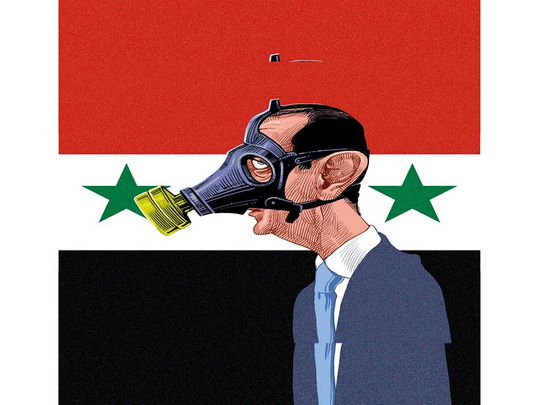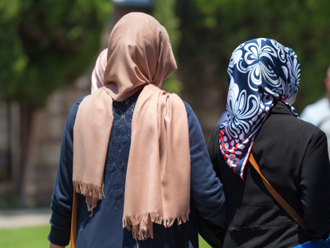
In one of his latest tweets, US President Donald Trump called the Syrian President Bashar Al Assad “an animal” following the chemical attack on Douma, in the outskirts of the capital killing at least 70 civilians last Saturday. He also lashed out in the strongest terms at the trio of Russia, Iran and Al Assad and warned they “will pay a big price”. A week earlier, the American president said in another tweet that he was pulling out altogether from Syria “and will leave the others to sort it out”, but three days later he was persuaded “not to pull out immediately”.
What a “strategy”, if one could it as such. US current involvement in Syria is limited to its 2,000 personnel on the ground in Eastern Syria. Their main task has been to support an alliance of Kurdish and Arab militias called the Syrian Democratic Forces (SDF). But with Turkey, a major Nato member and close US ally, extending its military campaign against the Kurds into North and Eastern parts of Syria, is calling the American support to SDF into question. The US-led coalition air strikes have aided SDF fighters, over the last three years, to capture thousands of square kilometres of territory from Daesh [the self-proclaimed Islamic State of Iraq and Syria].
Russia and Iran have been largely the main suppliers of air and ground forces to the regime in Damascus. Douma is the last rebel stronghold in the Eastern Ghouta, a district outside the capital, following consecutive offensive and evacuation deals heavily supported by both Moscow and Tehran.
Now after the latest atrocities in Douma, will Trump have a strategy for Syria? If he will, what it is. To structure such a strategy, Trump needs to start from a very simple question: why Al Assad used chemical weapons? He doesn’t need to search for long as the answer is clear. Al Assad feels comfortably confident for two reasons: powerful Russian cover and pathetic American presence. Al Assad is obviously convinced, under such circumstances, no one will try to stop him no matter how far he goes with his deadly killing machine.
The best the US president would do is resort to fire few Tomahawk missiles against some military installations, as he did almost exactly a year ago. But this action is far less than committing himself to a comprehensive strategy. Al Assad must have interpreted Trump’s intention to pull his forces out of Syria soon to mean there was no one standing in his way.
Judging from the slaughters in Syria over the last four years, Al Assad, Moscow, Tehran and Hezbollah feel free to do away with every evil action they commit, including the use of chemical agents. Why? Because nobody is ready to face up to, or act as a counterweight to Russia or Iran.
Last month, Britain has energetically campaigned and successfully recruited no less than 25 countries — including the US and most European countries — to support the government of Theresa May’s attack against president Vladimir Putin for suspecting Russia of using chemical agents to poison two Russian citizens in the English town of Salisbury- former Russian spy Sergei Skripal and his daughter Yulia, who are currently recovering in hospital.
Many are asking why a similar action is not happening in the case of the latest murderous use of chemical weapons in Douma. The use of chemical weapons has been forbidden internationally, but Al Assad is aware he’s got a green light to continue bombing and slaughtering his people without any serious deterrence. He knows very well that the United Nations Security Council’s hands are firmly tied so long as he openly enjoys Putin’s backing.
Al Assad’s air forces largely used chemical agent, Sarin, back in August 2013 against targets in Eastern and Western Ghouta where up to 1,400 victims were killed, including hundreds of defenceless children. Former president Barack Obama was about to retaliate with punitive actions, but last-minute agreement with the Russians to eliminate Al Assad’s arsenal of chemical weapons stopped Obama from taking such step. Despite 2013 agreement Al Assad used horrific gas weapons in 2017 in Idlib, Northern Syria. Trump retaliated targeting Shayrat air base in central Syria with 59 Tomahawk cruise missiles in less than 72 hours. For Damascus regime, Russia and Iran that was like a slap on Al Assad’s hand. This time round it is unlikely that the American president will go beyond that.
However, Al Assad’s use of chemical weapons seems to be serving well the trio (Al Assad, Moscow and Tehran) strategy. There is no other explanation for its use in Douma than psychological reasons. The ceasefire agreement in Douma, brokered by Russians was sealed and the rebels had already started to pull out from the town hours before chemicals were used. So, why Al Assad decided to opt to this devastating weapon in the process of implementing the agreement. Many observers believe its sudden use in the battle for Douma carries clear message to rebel groups in the rest of Syria, particularly in the North region of Idlib.
Nevertheless, slapping Al Assad’s hand is not sufficient action to deter him nor to contain Moscow’s and Tehran’s actions. The tomahawks option has been tried before to no avail and it seems the world is facing a situation of — to borrow a phrase — No End of a Lesson.
Mustapha Karkouti is a columnist and former president of the Foreign Press Association, London. Twitter: @mustaphatache









